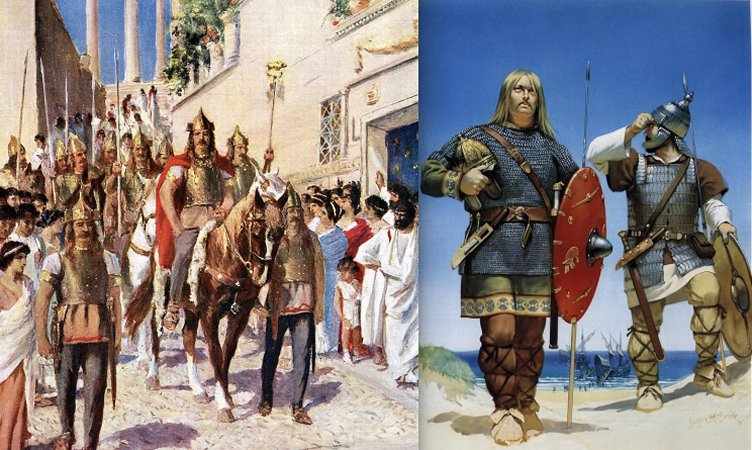Who Were The Goths And Where Did They Come From?
David Tee - AncientPages.com - There is a difference between the terms Visigoths and Ostrogoths.
The former word means western Goths and the latter means eastern Goths, but the Goths themselves rarely referred to themselves in this manner. Their beginnings, like most ancient civilizations, is lost to history.
Left: An illustration of Alaric entering Athens in 395. Credit: Public Domain - Right: Ancient warriors. Source
Some argue that the Goths originated in Scandinavia. Others claim the Goths were from Poland or some Germanic heritage. Herodotus made a connection between the Goths and the Scythians, but that identification may or may not be valid.
The people were often associated with barbaric practices and the term barbarian applied to anyone who didn’t speak Greek. Yet even with this wild reputation, somehow the Goths were able to influence the art and architecture worlds, including modern subculture. Their Gothic style was depicted as dark ad romantic.
The Goth’s Rise To Fame And Power
Tacitus spoke of the Goths as Germanic and a united people who were fierce fighters. Yet caution is given as Tacitus wrote about them in the 1st century AD and the majority of accounts come hundreds of years later. The people Tacitus wrote about may not be the same Goths of the 4th and 5th centuries AD.
Most of the Goth’s fame came after they started battling with the Romans. Not much is known about them prior to those conflicts. Their own runic language has few extant examples thus a complete history of the Goths is unobtainable.
Like the Persians before them, the Goths attacked Greece in the 3rd Century AD at the pass of Thermopylae but the outcome is not known. The recorded text ends before the victor could be identified. Decius, a Roman Emperor, suffered the loss of men and territory in the Greek wars with the Goths.
A love-hate relationship with Rome began somewhere in the 3rd r 4th centuries. The Goths would attack certain cities under Roman control, yet they would also serve as soldiers in the Roman legions. The two nations also traded with each other.
The Goths And The Huns
Even though they had a complicated relationship with the Romans, the Goths still had other enemies looking for their land. One of those enemies were the Huns. The Huns pushed the Goths territorially towards the Romans. The Romans did not like the Goths and subjugated them to humiliating treatment.
Gothic invasions in the 3rd century. Credit: Public Domain
The bad treatment finally broke the Goths and they rebelled against the Romans in the Balkans. Emperor Valens and his army were killed by the Goths at the battle of Adrianople in 378 AD. His successor, Theodosius, made a peace pact with the Goths that lasted until 395 AD.
Alaric came to the Gothic throne just as the Western Roman Empire was coming apart and weakening. Taking advantage of the rebellions by other factions in Gaul and Britain. Alaric decided to lay a siege on Rome itself.
He was motivated by a failed earlier attempt to invade Italy and the massacre of Goths in the Eastern Roman Empire. Bolstered by runaway slaves and supporters of Stilicho, a Roman general killed by Honorius, Alaric and his army attacked Rome in 410 AD.
Sadly, for Alaric, he died shortly after conquering Rome.
The End Of The Goths
Prior to Alaric’s victory, the Goths did divide themselves. One group of Goths were friendly to Rome and willingly adapted to the Roman lifestyle. Led by Fritigin, the one faction became Christians under the Arian banner.
The other faction remained more or less pagan and were led by a staunch anti-Romist Athanaric. The two factions went to battle with Athanaric winning the war. The defeat helped push Fritigin closer to the Romans and it helped lead to a guerilla type war between Athanric and the Romans.
This type of warfare would have been won by the Goths if it had not been for the intervention of Attila the Hun and his army. The Huns destroyed the Goths food supply forcing Athanric to make a treaty with Rome.
Even with this intervention, some of the Goths allied themselves with the Huns and continued to battle Rome. But as history showed, that whenever the Goths got a successful foothold, someone was always there to take it away from them.
After the 2nd Gothic War, the Goths disappeared from history.
Written by – David Tee AncientPages.com Staff Writer
Copyright © AncientPages.com All rights reserved. This material may not be published, broadcast, rewritten or redistributed in whole or part without the express written permission of AncientPages.com
Expand for referencesMore From Ancient Pages
-
 What Happened To The Mysterious And Beautiful Queen Nefertiti?
Featured Stories | Apr 4, 2017
What Happened To The Mysterious And Beautiful Queen Nefertiti?
Featured Stories | Apr 4, 2017 -
 ‘The Battle Of The Tooth Worm’ – Strange Ivory Carving
Artifacts | Aug 11, 2015
‘The Battle Of The Tooth Worm’ – Strange Ivory Carving
Artifacts | Aug 11, 2015 -
 On This Day In History: ‘The Wars Of The Roses’ – Fighting For The Throne Of England At Tewkesbury – On May 4, 1471
News | May 4, 2016
On This Day In History: ‘The Wars Of The Roses’ – Fighting For The Throne Of England At Tewkesbury – On May 4, 1471
News | May 4, 2016 -
 Isaac Newton Believed Egyptian Pyramids Held Key To The Apocalypse – Unpublished Manuscripts Reveal
News | Dec 10, 2020
Isaac Newton Believed Egyptian Pyramids Held Key To The Apocalypse – Unpublished Manuscripts Reveal
News | Dec 10, 2020 -
 On This Day In History: Julius Caesar Dedicated Temple To Venus Genetrix – On Sep 26, 46 BC
News | Sep 26, 2016
On This Day In History: Julius Caesar Dedicated Temple To Venus Genetrix – On Sep 26, 46 BC
News | Sep 26, 2016 -
 Tiglath Pileser III: Neo-Assyria’s Strong King Who Built A Mighty Empire
Featured Stories | May 2, 2019
Tiglath Pileser III: Neo-Assyria’s Strong King Who Built A Mighty Empire
Featured Stories | May 2, 2019 -
 Syamantaka – Divine Jewel With Magical Powers Was A Gift From The Sun God In Hindu Mythology
Featured Stories | Mar 1, 2019
Syamantaka – Divine Jewel With Magical Powers Was A Gift From The Sun God In Hindu Mythology
Featured Stories | Mar 1, 2019 -
 Rose Cross – Powerful Symbol That Existed Long Before Christianity
Ancient Symbols | Dec 3, 2017
Rose Cross – Powerful Symbol That Existed Long Before Christianity
Ancient Symbols | Dec 3, 2017 -
 Why Is A Snake Symbol Of Medicine And Pharmacies?
Ancient History Facts | Jan 15, 2018
Why Is A Snake Symbol Of Medicine And Pharmacies?
Ancient History Facts | Jan 15, 2018 -
 Rare Viking Boat Burial At Kiloran Bay In Colonsay, Scotland Remains A Fascinating Find
Featured Stories | Mar 6, 2023
Rare Viking Boat Burial At Kiloran Bay In Colonsay, Scotland Remains A Fascinating Find
Featured Stories | Mar 6, 2023 -
 The Man Who Took The Greatest Alchemy Secret Of All Time To His Grave
Featured Stories | Jul 16, 2020
The Man Who Took The Greatest Alchemy Secret Of All Time To His Grave
Featured Stories | Jul 16, 2020 -
 Killer-Of-Enemies – Mysterious Non-Human Teacher And Hero Of The Apache Indians
Featured Stories | Nov 16, 2020
Killer-Of-Enemies – Mysterious Non-Human Teacher And Hero Of The Apache Indians
Featured Stories | Nov 16, 2020 -
 Brahma: First God In Hindu Trimurti, Creator Of The World And All Creatures
Featured Stories | Apr 17, 2019
Brahma: First God In Hindu Trimurti, Creator Of The World And All Creatures
Featured Stories | Apr 17, 2019 -
 Pre-Inca Societies In The Andes Lacked Hierarchical Leadership And Shared Power Before The Incas Arrived
Archaeology | Dec 13, 2017
Pre-Inca Societies In The Andes Lacked Hierarchical Leadership And Shared Power Before The Incas Arrived
Archaeology | Dec 13, 2017 -
 Nicholas Roerich’s Search For Shambhala And Wish To Fulfill The Mysterious Buddhist Prophecy
Featured Stories | Nov 4, 2016
Nicholas Roerich’s Search For Shambhala And Wish To Fulfill The Mysterious Buddhist Prophecy
Featured Stories | Nov 4, 2016 -
 Mysterious Fossilized Antarctic Forest May Offer Evidence Of The Great Flood – But Some Facts Speak Against This Theory
Archaeology | Dec 27, 2017
Mysterious Fossilized Antarctic Forest May Offer Evidence Of The Great Flood – But Some Facts Speak Against This Theory
Archaeology | Dec 27, 2017 -
 King Offa Of Mercia And The Murder Of King Ethelbert – Revenge Or Jealousy?
Featured Stories | Jul 19, 2018
King Offa Of Mercia And The Murder Of King Ethelbert – Revenge Or Jealousy?
Featured Stories | Jul 19, 2018 -
 Altai Mountains Were Home To Porcupines 30,000 Years Ago
Archaeology | Mar 14, 2017
Altai Mountains Were Home To Porcupines 30,000 Years Ago
Archaeology | Mar 14, 2017 -
 Ancient Nanotechnology Knowledge Inspired A Modern 3D-Printable ‘Lycurgus Cup’
Ancient Technology | Mar 13, 2019
Ancient Nanotechnology Knowledge Inspired A Modern 3D-Printable ‘Lycurgus Cup’
Ancient Technology | Mar 13, 2019 -
 Mysterious Disappearance Of Rome’s Founder Romulus And Strange Vision Of Proculus That United Ancient Romans
Featured Stories | May 26, 2021
Mysterious Disappearance Of Rome’s Founder Romulus And Strange Vision Of Proculus That United Ancient Romans
Featured Stories | May 26, 2021


